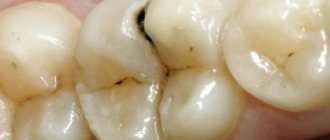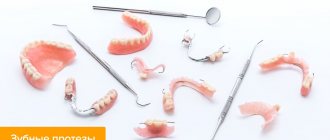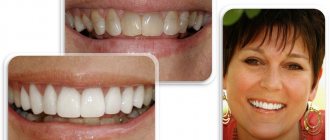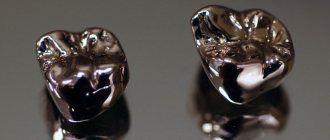Have you had to replace old fillings installed several years ago? Do you know what this threatens?
We will tell you how to avoid frequent replacement of fillings by using another dental restoration technology. In the article Filling, inlay or crown? We reviewed different methods of dental restoration, and today we will tell you in detail about the advantages of inlays .
An inlay is a filling made in a dental laboratory from filling materials, metals or ceramics.
Restoring a tooth with an inlay is more expensive than with a regular filling, and to understand whether it’s worth paying more , let’s figure out why an inlay is better than a filling. The benefits of inlays become obvious if you understand the reasons for replacing old fillings.
Let's start with the functions that the filling performs.
Material shrinkage is one of the reasons for replacing old fillings
Protection of the tooth from infection is ensured by the tightness of the connection at the border of the filling with the tooth tissue. Modern adhesive compounds reliably glue the filling to the tooth, but sometimes this can become a problem.
During curing, any material decreases in volume ( shrinks ) and filling material is no exception. By shrinking, the filling “pulls” on itself the parts of the tooth to which it is securely glued, and if the area of the filling is large, this force may be enough to cause cracks and chips to appear.
secondary caries forms at the site where the filling is torn from the tooth tissue .
Shrinkage of the filling material also poses other problems:
- with vertical shrinkage, the height of the bite changes, which leads to dysfunction of the temporomandibular joint and improper load on the filled tooth. As a result, the tooth may become damaged and require a crown to be installed to restore it.
- shrinkage of the filling horizontally leads to the disappearance of the contact point (point of contact) between adjacent teeth and stuck food puts pressure on the periodontal papilla, injuring it. The gums become inflamed, gingivitis, periodontitis and secondary caries develop.
How much does a filling cost?
Before answering this question, you need to understand what is included in the price. Before placing a filling, the doctor must remove tissue damaged by caries, fill it with filling material, grind and polish the restored tooth. In most cases, the cost of a filling is included in the price for caries treatment, which averages from 1,000 to 3,000 rubles in economy class clinics (although in some price lists you can find prices starting from 500 rubles), it will cost from 4,000 rubles treatment of caries and installation of a light filling in business-class dentists and from 6,000 rubles in premium clinics and VIP dentists in Moscow.
What are the consequences of insufficient filling strength?
The technology for making a filling (in the patient’s mouth) does not make it as strong as possible, so over time the filling material wears out.
As in the case of vertical shrinkage, abrasion of the filling can lead to problems:
- the level of bite changes , and this can lead to the chipping of part of the tooth due to the redistribution of the chewing load from the filling to the walls of the tooth.
- the boundary between the filling and the tooth tissue changes , while the filling loses its tightness and the infection penetrating inside provokes the development of secondary caries.
Is a refilling necessary if nothing bothers me?
Many patients are surprised when a dentist recommends replacing an old filling with a new one, because they have no pain or other unpleasant symptoms. However, replacement is carried out not only in cases of severe inflammation, but also for preventive purposes, as well as to improve the aesthetics of the dentition.
Like any other material, the filling mass is subject to gradual wear, deformation, and destruction. Hygienic care, oral microorganisms, saliva pH, mechanical, chemical and temperature effects of food over time provoke the appearance of microscopic cracks in the filling. The resulting pores serve as a breeding ground for microbes and the development of dental diseases.
Other disadvantages of the filling and reasons for replacing it
- Inaccurate anatomical shape of the tooth.
Restoring the correct shape of a tooth in a patient’s mouth is a difficult task. This work requires the dental therapist to have a good knowledge of anatomy and the skill of a sculptor. But even with these skills, it is difficult to model the shape of a tooth in hard-to-reach places.Inaccurate tooth shape is the cause of malocclusion (especially if there are a lot of fillings). Teeth grind food incorrectly, causing discomfort when biting, headaches appear, teeth are injured in the process of chewing food and are destroyed over time.
- Overhanging edges of the filling.
If, when installing a filling, the material flows onto the gum and rests on it, this leads to permanent injury and inflammation of the gums.A filling installed with such a defect causes local periodontitis and secondary caries, since it is difficult to remove stuck food from the resulting “pocket.”
- Difficulty in thoroughly sanding surfaces .
In places of contact with neighboring teeth, it is impossible to completely get rid of the roughness of the filling, and dental plaque adheres well to such a surface. - Development of caries at the interface between tooth and filling . The gradual shrinkage of the filling material and the destruction of the adhesive connection makes the border between the tooth and the filling the most vulnerable place where secondary caries develops first.
- Changes in the color of the filling material and tooth tissue over time make the border of the filling too noticeable.
Why does caries develop under the filling mass?
The development of a carious process under the filling material is often observed due to poor-quality treatment of the tooth cavity during treatment. The remains of the affected tissues serve as a source of infection, which intensifies and covers increasingly larger areas of the dentition unit.
Caries can also form if the filling is carried out in violation of the protocol. An incorrectly applied composition quickly becomes unusable, losing its fixation with the walls of the tooth cavity or collapsing under the influence of the aggressive environment of the oral cavity. Microbes penetrate into the resulting cracks and voids, which “trigger” the destructive process.
Another factor that provokes the development of caries is the natural “aging” of the filling. The appearance of microdamages (and micropores) on it and in it, which is inevitable over time, contributes to the accumulation of pathogenic bacteria, their reproduction, and the occurrence of recurrent disease. Therefore, it is advisable to replace old fillings with new ones after their expiration date.
What does replacing a filling lead to?
What's wrong with changing the filling when needed? The problem is that you don’t know the exact time when the old filling stops performing its functions, but if part of the tooth breaks off, the doctor will be forced to put in a new, larger filling.
In the case of advanced caries and pulpitis, it may be necessary to remove the nerve, but a “dead” tooth is more fragile and fillings and inlays adhere less well to its tissues (which means the service life will be shorter).
We devoted the article Karis to the treatment of different stages of caries: what is it like? And why does treatment differ so much in price? Read it to understand how caries progresses.
With each filling replacement, the “native” tooth becomes smaller and the moment approaches when it can only be restored with a crown.
How does the replacement take place?
Many patients are worried: is it painful to change a filling? The procedure is performed under local anesthesia and is therefore absolutely painless.
In general terms, re-sealing occurs as follows:
- anesthesia is administered
- the desired tooth is isolated from the oral cavity with a rubber dam: so that moisture and microorganisms do not enter the treated cavity,
- old filling material and tissues affected by caries (if any) are removed
- the cavity is treated with a special etching solution and dried,
- an insulating or medicinal pad is applied,
- a new filling is applied.
Restoration takes place with mandatory consideration of the anatomical features of the chewing surface.
Why is a ceramic inlay better than a regular filling?
Unlike a filling, which a doctor makes in the mouth, an inlay goes through all stages of manufacturing in a dental laboratory. The dentist only processes the tooth cavity under the inlay and makes impressions of the jaws, and after making the inlay, glues it in place.
Restoring a tooth with an inlay requires two visits to the dentist, but ensures long-term functionality and aesthetic perfection of the restoration.
Advantages of ceramic inlays:
- Inlays do not shrink after placement because this process is completed during the manufacturing stage in the dental laboratory.
- Ceramic inlays have the highest strength and do not wear out over time, thanks to production technology. The inlay is pressed from a ceramic mass heated to high temperatures or machined from a single piece of ceramic.
- Inlays completely restore the anatomical shape of the tooth and chewing functions, thanks to the modeling of the bite in the articulator using casts of two jaws.
- Making an inlay with fitting on a plaster model makes it possible to create it without overhanging edges , restore tooth defects in hard-to-reach places, ensure correct interdental contact and good marginal fit of the inlay to the tooth. All this is difficult to do when making a filling in the oral cavity.
- All outer surfaces of the inlay (including those in contact with adjacent teeth) are perfectly ground before installation.
- It is easier to select the desired color and translucency of the inlay in the laboratory than in the patient’s mouth. Therefore, ceramic inlays are the best option for aesthetic dental restoration.
- The inlay is more reliably glued to the tooth, since the doctor requires a minimum of time to install an inlay of exactly the right size into the treated tooth cavity (due to the speed of installation, the risk of moisture and infection on the treated surfaces is reduced).
By restoring a tooth with a ceramic inlay, you get a high-quality, durable restoration and do not get tired during the appointment, since you do not need to sit for a long time with your mouth open.
For medical reasons, if the coronal part of the tooth is destroyed by more than 30%, it is recommended to install an inlay.
Modern filling materials
In modern dentistry, a new generation of light-polymer materials is used, which have replaced the old cement, acrylic, and amalgam fillings. Their characteristic features are:
- high degree of strength;
- long service life;
- excellent aesthetic indicators;
- strong adhesive adhesion;
- Can be used on all teeth.
New generation fillings
Zinc phosphate, glass ionomer zinc eugenol filling cements differ from previously produced ones:
- increased strength;
- wear resistance;
- high aesthetic indicators.
Composite and ceramic inlays
They are made from individual impressions, which the doctor takes from the patient’s teeth. Inlays are used when more than 50% of the tooth is damaged. They can be restorative and stump. The first ones are used to restore the shape of the tooth, the second ones are used for further installation of crowns on them.
Crowns
In cases where simply replacing the filling is no longer enough, crowns are used. We can say that the crown is the last line on the path of tooth destruction. The next step is the removal and subsequent installation of a bridge, which threatens the integrity of the adjacent dental units, which are to be ground and serve as a support for the prosthesis, or the implantation of a titanium root.
To avoid giving dental caries and related diseases a chance, don’t forget to periodically make an appointment with your dentist. At the Plomba family dentistry clinic, you will be treated by specialists with many years of experience who have modern materials and technologies at their disposal.
Types of ceramic inlays
- inlay tab - restores the “cavities” of the tooth crown
- onlay tab - restores most of the chewing surface of the tooth crown
- overlay tab - restores the chewing surface and side walls of the tooth crown
The service life of the inlays is more than 10 years, while the filling will require replacement after an average of 5 years.
Now, when a dentist suggests restoring a tooth with an inlay, you know what benefits this will provide in the future.
How long can a filling last?
The service life of a filling is determined by several factors, the main ones being the following:
- correct installation and size,
- characteristics of the material from which it is made,
- the condition of the abutment tooth, the thickness of its walls,
- features of hygienic care: brush hardness, abrasiveness of pastes, etc.
- the presence or absence of certain habits: for example, high consumption of nuts, seeds, opening corks with teeth,
- the predominance of solid and/or tough foods in the diet, and so on.
As a rule, the minimum service life is 3-5 years, but some materials can last 10 years or more. In fact, it depends more on the condition of the treated tooth itself after a while.
What care do fillings require?
Filled teeth do not require any special care, but we must not forget that you need to brush them, regardless of whether they have fillings or not, at least twice a day and very carefully. Dentists also recommend attending professional oral hygiene procedures at least once every six months. In this case, the hygienist should grind existing fillings and pay special attention to them.
You also need to remember that filling material is still more porous than enamel, so it absorbs pigments from coloring foods and drinks more strongly. That is why, immediately after caries treatment, it is not recommended to eat beets, red berries and similar foods for several days, especially when it comes to the front teeth.
Dental filling methods
All methods of filling teeth are based on the use of various materials, which have their own advantages and disadvantages. Therefore, when choosing a technology, the doctor focuses on the individual characteristics of the structure of the root canals and the patient’s body as a whole.
Filling teeth with gutta-percha
Removal of the nerve of the tooth and filling of the canals, when the cavity is filled with a special paste based on gutta-percha with the addition of various impurities. Despite its simplicity and relatively low cost, this method of filling teeth cannot be called reliable and safe. It is often accompanied by a violation of tightness, the development of inflammation and allergic reactions.
Using a pin
Filling a pulpless tooth with pins is one of the most common techniques in dentistry. There are two types of pins (fillers): gutta-percha and metal. Filling tooth canals with gutta-percha is considered a more reliable and safe method. Even taking into account the presence of polymers, dyes and metal salts, such pins are biocompatible and do not cause allergies. Silver metal structures have good flexibility and can be installed in long and curved channels, however, silver is prone to oxidation, which can lead to inflammation. Titanium posts are better in terms of tissue compatibility, but they are very rigid and require the preparation of a special bed, which makes the tooth walls extremely fragile.
Sealers-sealers
Even gutta-percha pins for filling the root canals of teeth by themselves are not able to provide a reliable result, since they do not have antibacterial properties. To improve the quality of filling, dentists use sealers - sealants that ensure a tight fit of the material to the canal walls. There are natural (based on cement, zinc oxide, etc.), polymer sealers, glass ionomer cements and pastes based on calcium hydroxide.
What are the complications after installing a filling?
The most common complaint from patients after visiting the dentist is a feeling as if the tooth under the filling hurts. Such sensations are absolutely normal for several hours after treatment (up to 1 day), but if the pain does not subside the next day, this may mean that the doctor made a mistake, for example, did not properly treat the carious cavity before installing a filling. If a day has passed and the tooth still hurts, you need to go to the dentist again, you may have to take an x-ray and, if necessary, re-treat.
Another common reason for visiting a dentist is when a filling has fallen out. As we have already said, these structures have a certain service life, after which they need to be replaced; if this is not done, they can actually fall out. And in such situations, the main thing is to understand why this happened - because the tooth was not treated for a long time, or did secondary caries develop in it? As for fresh fillings, they can only fall out in the event of a medical error. Therefore, choose proven clinics where quality fillings are installed in Moscow.
Filling of anterior teeth
In the case of front teeth, the aesthetic aspect comes to the fore, so the filling material must have the appropriate properties. Although the front teeth receive better hygiene due to their accessibility, they are also susceptible to caries. Installing a filling on the front teeth is considered a more complex procedure: it is necessary not only to give the filling the desired shape, but also to choose the right color. In most cases, filling of anterior teeth is carried out using compomers, as well as light composite fillings, which harden under the influence of ultraviolet radiation. Be that as it may, in case of serious damage, it is impossible to achieve good aesthetics with the help of filling, so you often have to turn to orthopedic solutions.
Why do you need dental filling?
The first experiments with the installation of fillings were carried out before our era. Holes in the teeth were filled with resin and various mixtures. However, the archaic technique of filling teeth brought almost no positive results. Fortunately, today everything has changed dramatically. Modern fillings are successfully used to perform a variety of tasks, in particular for:
- functional filling
- aesthetic dental filling
- filling root canals
- temporary sealing of a damaged tooth











